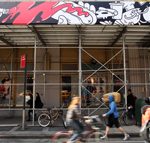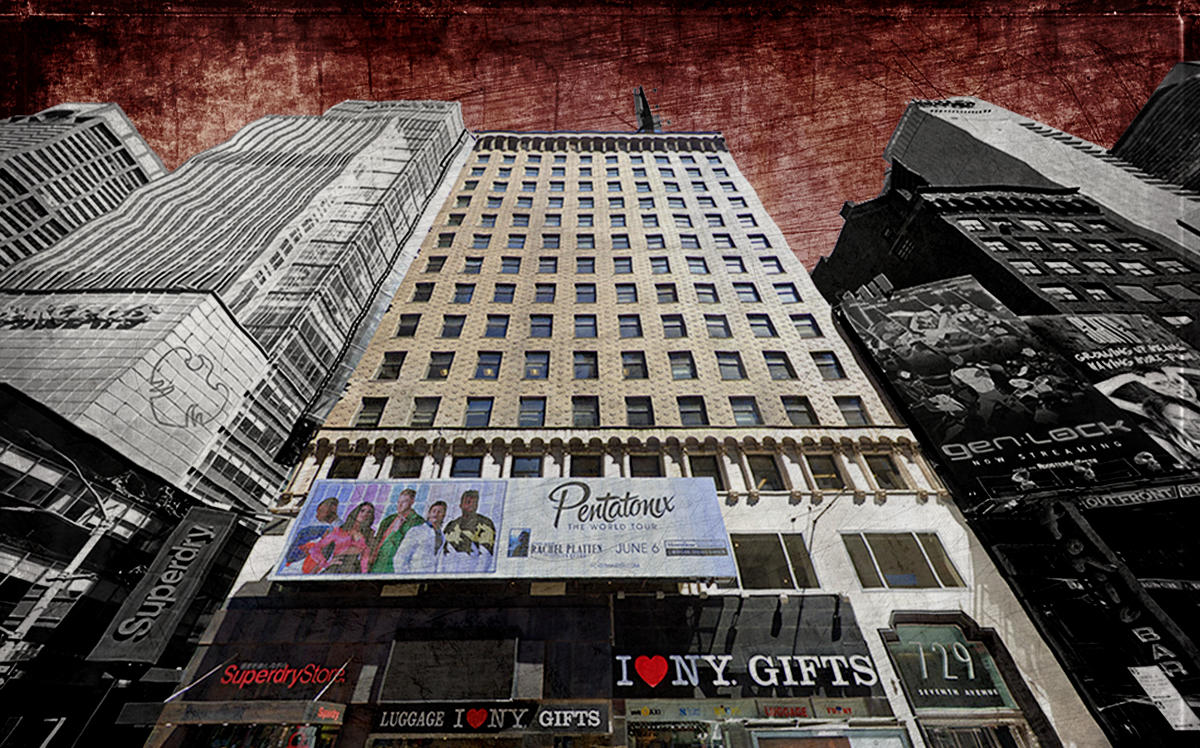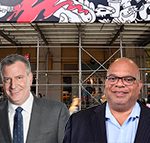 DOB map shows 280 miles of scaffolding in the city
DOB map shows 280 miles of scaffolding in the city
Trending
 Lawmakers reach sweeping housing deal with “good cause eviction,” new 421a
Lawmakers reach sweeping housing deal with “good cause eviction,” new 421a City Council approves zoning change to greenlight casinos
City Council approves zoning change to greenlight casinos Tony Park and Elad Dror take a gamble on Koreatown office-to-resi conversion
Tony Park and Elad Dror take a gamble on Koreatown office-to-resi conversion Dan Kodsi scores $86M construction financing package for 420-unit rental complex near Orlando
Dan Kodsi scores $86M construction financing package for 420-unit rental complex near OrlandoAfter fatality, analysis shows façade rules widely ignored across city
Most violations like the one in this week's tragedy remain active; higher penalties are pending

Nearly eight months ago, city officials issued a violation against the owner of 729 Seventh Avenue for failing to maintain the building’s façade. The owner, Himmel + Meringoff Properties, paid a $1,250 penalty but never documented that the damaged terra-cotta identified by city inspectors was repaired. Nor did it install a sidewalk shed to protect passersby.
The killing of a pedestrian Tuesday by a chunk of façade from the Times Square building called attention to the building’s history. But analyses by The Real Deal and the Department of Buildings show that many landlords continue to defy requirements that they regularly inspect and repair facades and report those actions.
TRD found 4,790 Environmental Control Board violations related to façades issued over the past nearly six years. More than half — 2,474 — remain active. The city is owed nearly $3 million for those infractions.
Most of the recent violations were for failing to report inspections or repairs. Although deaths from crumbling façades are rare, this lack of disclosure makes it difficult for regulators to assess the danger looming above pedestrians.
But when a fatality occurs, they typically spring into action. After the falling debris from the 17-story Himmel + Meringoff property claimed the life of architect Erica Tishman, 60, the Department of Buildings undertook a citywide sweep of all 1,331 façades deemed to require urgent work.
“Following this tragic incident, we have been sweeping façades around the city that have already been identified as needing immediate repairs, going building by building to order additional protections for the public if needed,” a Department of Buildings spokesperson said in a statement Wednesday. “Owners must be held accountable for the safety of their buildings to keep New Yorkers safe.”
An analysis by the agency separate from TRD’s tallied more than 22,000 violations since 2014 related to facades. The number includes a broader range of construction code violations.
Read more
 DOB map shows 280 miles of scaffolding in the city
DOB map shows 280 miles of scaffolding in the city
 Cure is worse than the disease for sidewalk shed problem, REBNY and city say
Cure is worse than the disease for sidewalk shed problem, REBNY and city say
In the wake of Tishman’s death, some said more needs to be done.
State Sen. Brad Hoylman, a Manhattan Democrat, said he hopes there is a criminal investigation into Tuesday’s incident, and recommended the city and state consider increasing fines and criminal penalties for such violations.
“I think that we need to ensure that owners don’t treat these open violations and fines associated with them as just the cost of doing business,” Hoylman said. “It’s maddening that this situation seems to repeat itself every few years.”
Representatives for Himmel + Meringoff declined to comment on the April violations.
Since the 1979 death of a student who was crushed by masonry that fell from a Columbia University building, the city has ramped up rules to prevent such incidents. Under Local Law 11, owners of buildings six stories or larger must have their properties’ façades inspected by a licensed professional every five years. But the quality of that reporting has been inconsistent.
The Department of Buildings is considering adopting new inspection rules in light of “significant deficiencies in façade compliance reporting by registered design professionals,” according to the agency. A hearing is slated for Dec. 30 on the changes, which would ramp up experience and responsibilities required for exterior wall inspectors and increase the penalty for failing to file an acceptable report to $2,000 per year from $1,000.
The changes would also double — to $500 — the monthly penalty that is stacked on top of the annual one for failure to file.
The agency would also build on the $1,000-per-month fine for failure to correct an unsafe condition, adding a monthly fine that rises with the size of the sidewalk shed. The idea is to discourage owners from keeping sheds up year after year rather than making the necessary repairs.
“I think the penalties and violations do accrue quite quickly,” said Carolyn Caste, director of façade compliance at Howard L. Zimmerman Architects. “Unfortunately there are owners out there that choose to ignore these things.”
Some 3,092 sidewalk sheds are in place throughout the city related to Local Law 11, either for unsafe conditions or ongoing façade maintenance. The sheds have been in place for an average of 362 days. Legislative efforts to relieve the city of its plague of sidewalk sheds without compromising safety or inflicting unnecessary costs on building owners have not come to fruition.
At 729 Seventh Avenue, inspectors determined that the building’s façade had to be fixed. Though he couldn’t comment on the specifics of that property, Craig Hargrove, director of architecture at Hoffmann Architects, said terra-cotta typically is a construction material that requires more caution. It’s one area the city may look at more closely, he said.
A clay-based material akin to brick, terra-cotta is porous and can develop cracks and corrosion that are harder to spot than with other materials, Hargrove said.
“It’s problematic because you can’t see the deterioration that’s occurring,” he said. “If we’re diagnosing terra-cotta we certainly pay very close attention to it.”
After a 2-year-old girl was killed in 2015 by a terra-cotta that fell from the Esplanade Luxury Senior Residences on West End Avenue, the Department of Buildings issued new requirements calling for more comprehensive inspections of terra-cotta and sandstone façades.
“The façade division is a group of very smart, very diligent people who have kept ratcheting up requirements every five years to meet the needs of the public,” said Howard Zimmerman, head of Howard L. Zimmerman Architects.
Earlier this year, a piece of concrete fell from 182 Lafayette Street in Soho and struck a pedestrian, whose umbrella bore the brunt of the impact. A check of city records found no evidence that the owner has since made repairs.
Landlords have to protect the public if a building façade is unsafe, and the most common method is to install a shed or, if that’s not enough, a net, Hargrove said.
Hargrove noted that façade inspections by the Buildings Department have increased in the last couple of years. “But sometimes,” he said, “that’s not enough to compel owners to do things in a timely manner, unfortunately.”
Something like a broken piece of glass in a façade window is technically an unsafe condition, Hargrove said, and can be resolved in a few days. But issues involving masonry tend to be much costlier and time-consuming, requiring landlords to submit applications to the city and gather bids for work. Those fixes can take months or more than a year.
If an owner doesn’t make the needed repairs in time, it can lead to other issues. Open violations can prevent landlords from securing other building permits or selling a property, Caste noted.
At the Times Square building where Tishman was killed, a sidewalk shed was erected that night and an electrical worker was on site Wednesday to install its lighting.
After issuing the April violation, the Department of Buildings hit the owners with another violation for failing to address the issue, for example by installing netting or a sidewalk shed or by removing the potentially dangerous masonry. The agency said in a statement that the owner challenged the violations.
